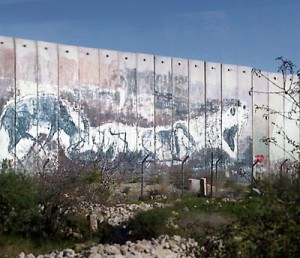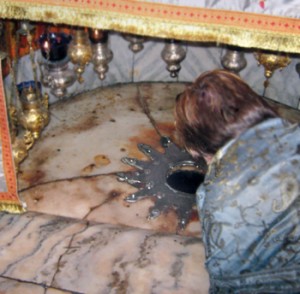Oh little town, have you really changed?
by Mark Hartburg
“Do You Hear What I Hear?” is the title of a modern Christmas carol penned in October 1962 by Noël Regney with music by his then-wife, Gloria Shayne Baker, a song recorded by hundreds of artists from Bing Crosby to Gladys Knight.
Regney, from the region of Alsace, was drafted by the Nazis and became a double agent for the French Resistance in World War II. He was wounded while leading German troops into an ambush and in the aftermath of the war rejected his Roman Catholic faith and became a Unitarian Universalist.
He wrote this Christmas song during the Cuban Missile Crisis when it seemed the whole world was going to end under a rain of nuclear bombs. Watching babies pushed in strollers on the sidewalks of New York City, oblivious to their potential doom under a mushroom cloud inspired Regney to write the lyrics “Said the night wind to the little lamb, ‘Do you see what I see?’” and “Pray for peace, people everywhere.”
What does this have to do with Christmas 2010?
This past September and October my wife and I along with thirty-one others toured Germany and the Holy Land. After witnessing the Passion Play in Oberammergau we headed to Israel where we explored some of the scenes and sites of Biblical events.
Our travels took us to Herod’s palace complex in Caesarea Maritima where St. Paul stood before the king and prefect; to Capernaum’s synagogue whose foundation likely touched the feet of our Lord Jesus; to Jerusalem to stand beneath Golgotha and beside the tomb where our Lord’s sacrificed body was laid and was raised from the dead. We also had opportunity to visit Nazareth and Bethlehem, places so heavily involved in the events of this holy season.
What did we learn about Christmas while there? Here are some things:
• In Nazareth there are two proposed sites (one favoured by the Greeks, the other by Latins) for angel Gabriel’s appearance to Mary to announce the conception of the Son of the Most High in her womb).
• Nazareth was a very little town (some estimate no more than 150), which gave new insight into what Mary (and Joseph) might have experienced with this “premature” pregnancy.
• Their travels to Bethlehem would have taken them through some very rough country, especially if they took the traditional route on the far side of the Jordan, bypassing hated Samaria.
• The location of our Saviour’s birth took place in a cave, with the babe laid in a stone feeding trough, hopefully lined with clean hay.
• That in the centuries following, both Nazareth and Bethlehem came to have large populations of Arab Christians, with many descendents of Ishmael worshipping the Christ alongside children of Abraham and Gentiles.
What we didn’t anticipate was how the modern realities of life in the Holy Land impact these sacred places. We expected the high level of security, but it is quite another thing to deal with armed soldiers walking down the aisle of your tour bus, looking you in the eye, the muzzles of their automatic weapons (pointed down) mere centimetres from your chest as you show your passport.
I had studied the establishment of the Separation Barrier (Apartheid Wall to the Palestinians) but seeing it snaking everywhere through the landscape around Bethlehem, and then passing beneath its guard towers and seeing the angry graffiti splashed across it, added to the disturbance I felt in my spirit.
Our coach-driver spoke of seeing the bullet-riddled bodies of children lying in his neighbourhood in East Jerusalem. Even in the sacred precincts of the Church of the Nativity (the oldest church still standing in Christendom) the competing factions had finally allowed tradesmen to erect scaffolding to study the decades-needed repair of the roof (and then only under extreme pressure from the Palestinian Authority).
Oppression, violence and absence of peace were also prominent at the time of our Lord’s birth
Oppression, violence and absence of peace were also prominent at the time of our Lord’s birth. King Herod, a megalomaniac, thought nothing of building his magnificent kingdom projects on the backs of his people, even when it cost the lives of his politically-intriguing family members. Rome ruled with an iron-fist that allowed little dissent. The rulers of the religious elite demonstrated at Gethsemane and Calvary how far they would go to preserve their own power and privilege.
Soon after we returned from Israel, Iran’s President Ahmadinejad shouted his taunts across the border crossing we had passed just days before. NATO and Russia appear ready to build a shield to block missiles from Iran and North Korea. Evidently Al Qaeda continues to hunt for nuclear material. Once again the world cowers under threatening mushroom-shaped clouds.
So at this Christmastide Christians appropriately “pray for peace…everywhere.” but not the same kind of prayer as in Regney and Baker’s carol. Our prayer is to the Holy Child who grew up to be Prince of Peace and Lord of lords. By mounting Golgatha’s cross He bridged the separation barrier our sins opened between us and God and becomes “our peace” (Ephesians 2:14). His resurrection confirms that in Him we need not fear any of the signs of the times, neither war nor rumour of war, false prophets or persecution. Since the Babe of Bethlehem broke into our history and space for us and for our salvation, we can have the peace of God that passes all understanding, the peace this world will never give (Philippians 4:7, John 14:27).
This is one of the most important things we learned in Bethlehem and Nazareth as we knelt and touched the silver nativity star and filed past the altar marking the place where Mary conceived the Son of God. As the writing on the altar says in Latin: Verbum caro hic factum est (“The Word flesh here became”)—hic, here—here also today in our world, in our lives. The Word continues to “dwell among us . . . full of grace and truth” (John 1:14, 17). He continues to “bring us goodness and light” as Regney’s carol only partially understood.
We know we can have peace, shalom. And we can share that peace with those around us, inviting them to join us on Christmas and all the days following in adoring on bended knee, Christ the Lord, the once newborn and on the Last Day our returning and triumphal King.






